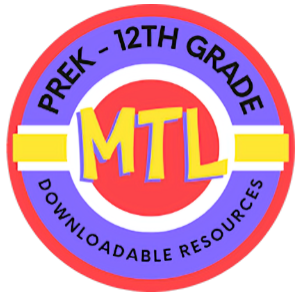Showing all 4 resultsSorted by latest
-
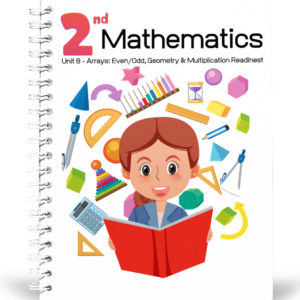 $5.00Buy Now
$5.00Buy NowIn this unit, students develop an understanding of equal groups, building on their experiences with skip-counting and with finding the sums of equal addends. The work here serves as the foundation for multiplication and division in grade 3 and beyond. Students begin by analyzing even and odd numbers of objects. They learn that any even number can be split into 2 equal groups or into groups of 2, with no objects left over. Students use visual patterns to identify whether numbers of objects are even or odd. Next, students learn about rectangular arrays. They describe arrays using mathematical terms (rows and columns). Students see the total number of objects as a sum of the objects in each row and as a sum of the objects in each column, which they express by writing equations with equal addends. They also recognize that there are many ways of seeing the equal groups in an array. Later, students transition from working with arrays containing discrete objects to equal-size squares within a rectangle. They build rectangular arrays using inch tiles and partition rectangles into rows and columns of equal-size squares. The work here sets the stage for the concept of area in grade 3.
Includes: Student and Teacher Editions
Size: 263 -
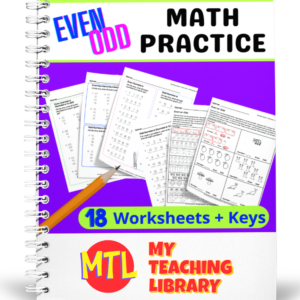 $3.00Buy Now
$3.00Buy NowGive students the practice they need to identify even and odd numbers! This resource includes 18 worksheets that progressively include higher numbers to really help students solidify their understanding.
Includes:
- – 4 worksheets (#’s to 20) w/ pictures: Students are to count and write how many, then create pairs (to determine if the number is even or odd) and then will circle even or odd.
- – 3 worksheets (#’s to 20) for students to identify odd numbers (given a sets of 6 numbers, they will circle every odd number)
- – 3 worksheets (#’s to 20) for students to identify even numbers (given a sets of 6 numbers, they will circle every even number)
- – 2 worksheets (#’s to 20) for students to identify both even and odd numbers (given a sets of 4 numbers, they will circle every even or odd number based on instructions given)
- – 4 worksheets (#’s to 50) for students to identify both even and odd numbers (given a sets of 4 numbers, they will circle every even or odd number based on instructions given)
- – 2 worksheets (#’s to 120) for students to identify both even and odd numbers (given a sets of 3 numbers, they will circle every even or odd number based on instructions given)
- – Answer Keys
Although 2nd grade skills require that students can identify even and odd numbers through 20, it is easy for them to go beyond twenty using this resource and the concepts they learn! Perfect to pair with Math Posters | Even – Odd Numbers
- – 4 worksheets (#’s to 20) w/ pictures: Students are to count and write how many, then create pairs (to determine if the number is even or odd) and then will circle even or odd.
-
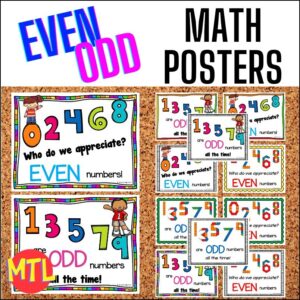 $2.25Buy Now
$2.25Buy NowTeaching students how to identify even and odd numbers? Here is a set of 12 posters (6 different sets of 2) that will be a great addition to your classroom decor.
-
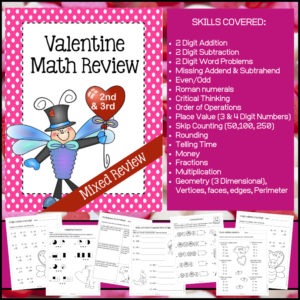 $8.00Buy Now
$8.00Buy NowThis February NO PREP packet is everything you’ll need for an entire month of Math review for 2nd and 3rd grades! This Valentine’s Day themed resource is jam packed with a variety of activities to get your students practicing and reinforcing important Math skills: addition, subtraction, multiplication, word problems, critical thinking, geometry, measurement, time, fractions and more.
Skills / Activities include:
- 2 digit addition (worksheets for ‘no carry’ and ‘carry’)
- 2 digit addition word problems
- 2 digit subtraction (worksheets for ‘no borrow’ and ‘borrowing’)
- Mixed addition/subtraction word problems (some worksheets designed in ‘test prep’ format)
- Find the missing addend and subtrahend worksheets
- 3 digit addition (worksheets for ‘no carry’ and ‘carry’)
- Even/Odd identification
- Roman numerals (I, V, X, L) – identification, conversion, addition
- Critical Thinking skill worksheets
- Order of Operations
- Place Value: Building 3 and 4 digit numbers / Expanding numbers
- Skip Counting by 50, 100, 250
- Rounding to the nearest 10 and nearest 100
- Telling time: nearest hour, half hour, 5 minutes and minutes
- Counting coins
- Fractions: identifying, comparing and naming
- Equivalent Fractions
- Multiplication: Writing equations
- Multiplication: 1-12
- Multiplication word problems
- Division word problems
- Measurement: Reading a ruler
- Geometry: Shape identification (cone, cube, pyramid, sphere, pentagon, rectangular prism
- Geometry: Vertices, faces, sides, edges
- Geometry: Finding the perimeter
